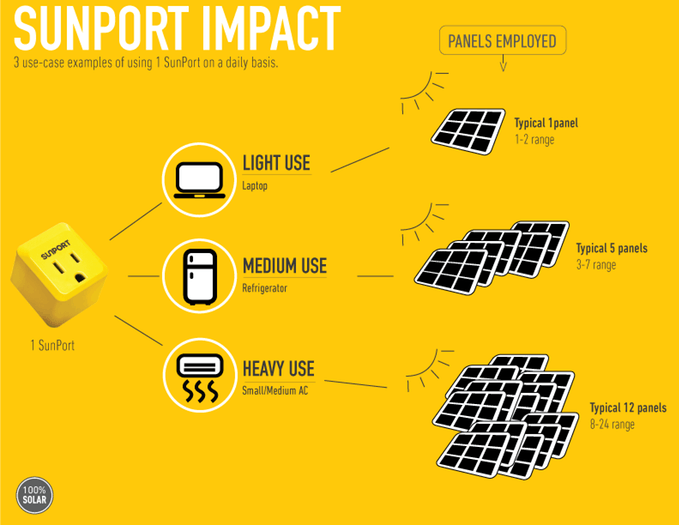Solar photovoltaic (PV) technology has come a long way in the past decade. Once seen as expensive, idealistic and useful only in niche applications, it has now entered the global mainstream and is rapidly becoming commonplace everywhere. The falling cost of solar panels is one of the main forces behind this revolution, but other outside-the-box innovations have also played a major role. Solar leases (a financing solution), for example, have played a huge role in the rapid uptake of rooftop solar in the United States. Likewise, community solar power programs – where residents virtually share the power produced by a solar farm in their area – has made solar energy accessible to those even without a roof of their own.
Now, US-based inventor Paul Droege has developed a device that will take solar access to another level entirely – a kind of solar wall socket called the ‘SunPort’ that lets anyone power any ordinary device with the sun. Described on the device’s KickStarter page as “the world’s first smart grid solar delivery device”, the SunPort promises to use the connectivity of the internet to allow anyone, anywhere to plug directly into solar. In theory, what this means is that as long as you have a SunPort in your pocket and access to an electrical socket, you could solar-power your laptop at home, then go to the library and solar-power it there as well.
“The use of a SunPort is not the same from an impact standpoint as having 30 panels on your roof,” Droege says in an interview with Big Think. “What is intriguing about it is that using a SunPort just sort of for little, everyday tasks, powering your laptop computer, or something like that, you could still use like 10 times as much solar as the average user on the grid, just by doing that. If you think of that as an amplifier of demand, it’s a pretty big deal. If people start using that, that’s kind of cool just by very modest tasks. If it’s done broadly, it really amplifies demand substantially.”

That’s the essence of what the SunPort promises, and it is already possible in the USA thanks to renewable energy certificate (REC) trading schemes, which exist in many states. The useful and entertaining video below explains how RECs work – and how the SunPort can allow anyone to access them.
Basically, for every unit of solar electricity that is generated in places with REC markets, one REC is created. By using the SunPort, anyone can have RECs associated with their ordinary energy use – with no need to invest in any hardware themselves.
But would it work in Australia? Given that Australia has a national REC market of its own set up through the federal Renewable Energy Target, it potentially could. However, while the exact details of how billing would work with the SunPort are still unclear, it seems likely that user would pay at least a slight premium for their access to the solar electricity. This is counter to what solar energy has long represented in Australia – that is, a technology that saves households and businesses money (while also being green).
Nevertheless, if used down under, SunPort could have interesting implications for the expansion of Australia’s solar energy market beyond homeowners – especially if the company can find a way to ensure that it delivers electricity at prices on par with or lower than retail electricity.
© 2015 Solar Choice Pty Ltd